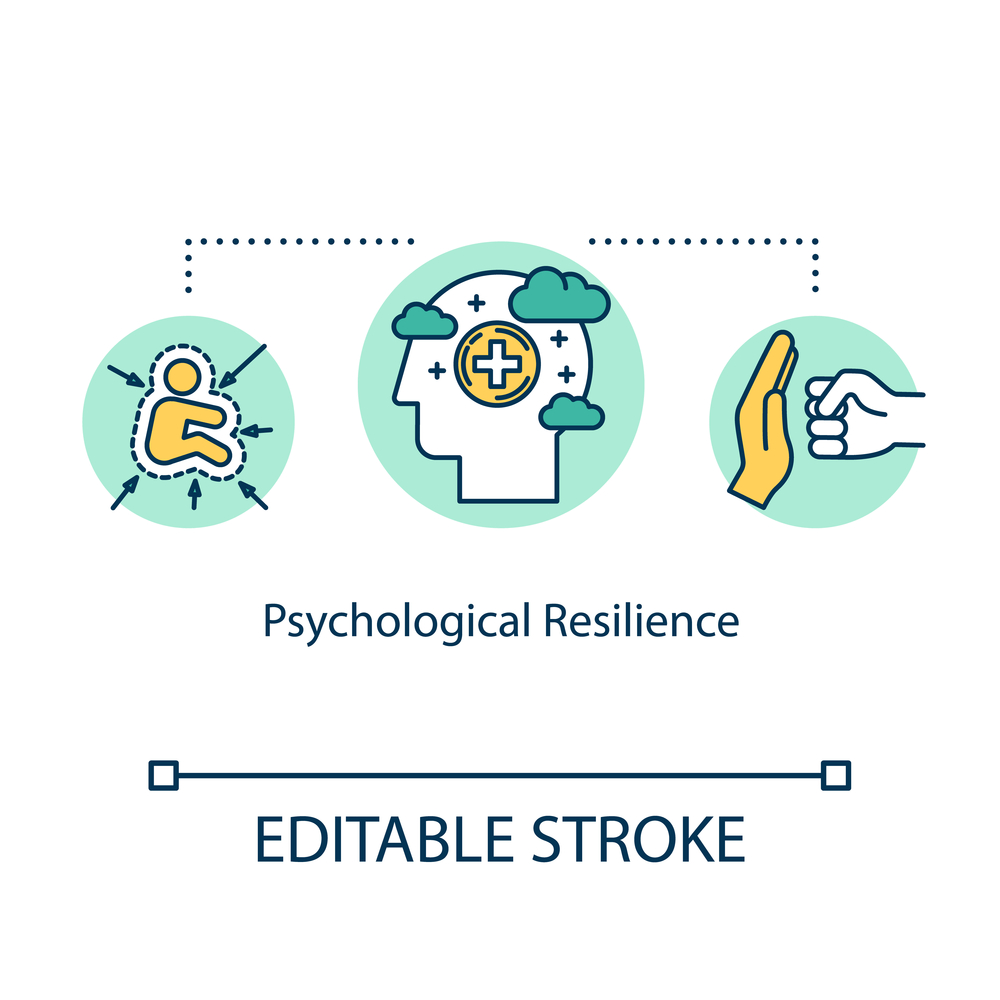Resilience is the ability of some individuals to adapt to changes, cope with traumas, serious problems or stressing situations, resignify them, and after a process, achieve a deep personal growth. Some people just have that capacity as an innate gift, but most of them learn it or develop throughout their life and could benefit from resilience training.
In the face of adversity, resilient people focus on those aspects that they can control, modify and improve. In other words, not only are they successful at going through difficult situations, but also they can emerge stronger after them.
Resilient people manage to transcend pain and perceive bad times as temporary. They have self-confidence and consider themselves capable and competent because they have managed to strengthen their psyches enough, and have developed a sense of mastery.

Instead, non-resilient people are emotionally affected by situations without being able to react. This may be due to psychological disturbances that have previously altered the person’s behavior. Before any change in the outside world, these people become too exposed and result vulnerable without knowing how to protect themselves.
They experience these situations with great anguish because they lead them to revive what has caused the trauma in the first place. Any change in their lives remains to the traumatic event, causing a deep pain and a revival of the trauma.

Although resilience is used to talk about adaptation and survival in general, we can identify four categories: psychological, emotional, physical and community.
Emotionally resilient people are not defined by what has caused them pain or suffering. They understand that trauma and stressors are part of their life, but they do not let themselves invade. They also keep good company, are surrounded by resilient people in every aspect of their lives and they find support within the adversity.
Among the competences of resilient individuals, we can find that they are conscious of their emotions and necessities, they listen to their bodies and ask for help when they need it. They practice acceptance and understand that pain is part of life, they do not deny or ignore suffering, nor they repress it, but they give place to emotions and trust they will recover and be better

They can be silent with themselves without distracting factors like radio or TV because they do not judge or avoid themselves. They do not get despaired by not having all the answers and because they trust they will find peace gradually. They also have healthy habits and take care of themselves, perhaps with daily routines.
For some people, resilience is an inborn condition. However, it can -and should- be developed throughout life. To resignify negative situations into something positive, you need to focus on these points:

5. Strengthen your social ties: If you have a strong and supportive social network, you will be better prepared to cope with challenges, deal with stress, and be a healthier and happier person. People with little support or conflict in their familiar or social relationships are often more vulnerable and have difficulty facing adversity.
6. Maintains a sense of humor: Those who can laugh in the face of adversity and maintain their sense of humor are less stressed and better prepared to cope with difficulty and bond with others in difficult times.
7. Exercise: Physical activity is directly related to resilience. The endorphins that are released positively affect your mood, and at the same time, help you stay healthy.
8. Develop your spiritual side: Be open to connect with yourself and do introspection with techniques such as meditation or yoga. Take time to think over and dedicate to yourself every day.
9. Do not give up: Try to maintain the effort in the long term without giving up in difficult situations and without stopping working to achieve your goals. Trust the process
If you think you cannot achieve it on your own, try with formal coaching. Some emotional resilience training and stress training will help you to succeed in focusing on these competencies.

Resilience is a skill The more developed it is, the more chances of academic and professional success that person will have and therefore, it is considered a great value. Resilient individuals can even be protected against suicidal thoughts after having suffered very traumatic events and can resist anxiety, depression, and self-doubt.
Resilience is a key factor for success because it allows people to prosper in any context, no matter how adverse it is, and turn it into an opportunity for growth. Many of the world’s most successful individuals have struggled a lot in their lives, and have had to recover from falls many times, but they still kept trying thanks to their resilience.
The good thing is that you can learn. Certain skills can be developed to have tools that will allow you to deal with situations in a resilient way. Resources such as personal resilience training can help you in this task.
The five basic resilience skills are:
Some research has shown that many students find it very difficult to make the transition to college and that stress can exacerbate pre-existing problems or precipitate new ones. However, when they find support and are encouraged to develop resilience skills and strategies, they are better prepared to succeed in their studies and in their future as professionals.

Resilience can be taught comprehensively with specific training, but parents, adults, and communities must encourage their learning to children so that they can develop it throughout their lives. It will give them more tools to deal with adversity.
In this sense, pediatrician Kenneth Ginsburg designed the 7C model that gives an approach to prepare children for life. The model consists of teaching seven abilities: Control, Competence, Coping, Confidence, Connection, Character, and Contribution.
4. Confidence: Help them build confidence by recognizing or congratulating them when they overcome obstacles, attributing success to effort, and not to luck.
5. Connection: Encourage the kid to express his or her feelings, give acceptance and continence when he or she does that.
6. Character: Help them explore who they are, what their values are, and what things they can share with others.
7. Contribution: Explore situations that allow the child to feel that he or she is giving and not just receiving. Let them feel that their contribution to the world is meaningful.



2. Attention: Focus on the here and now so you do not have to worry about the future or regret about the past. It will help to connect deeply and not worrying about unnecessary problems.
3. Letting go (physical): Release body tension, calm down, and reduce agitation.
4. Letting go (mental): Try to get away from your own thoughts, differentiate beliefs from reality.
5. Accessing & Sustaining Positivity: Focus on positive emotions so the negative ones will be naturally displaced.
At each stage of life, individuals must face events full of challenges and stress. Developing resilience will allow them to adequately adapt to the environment and overcome adversities.
Different traumatic situations can occur in the stages of childhood, adolescence, youth, and adulthood. Children and young people are more likely to face problems in their developmental process if they do not have enough family support or social support.
Complex or adverse situations in a person’s family cycle at this age can translate into problems in his or her future relationships, in mental health or in the functioning of their own families.
At the university stage, students may face high levels of stress to cope with academic demands. Emotional resilience will make it easier for them to cope with all these demands.

Resilience is not just a desirable quality for individuals. Companies and organizations can also have attitudes to anticipate, prepare, respond, and adapt to changes and disruptions that occur in the environment, and thus survive and prosper over time.
Organizational resilience goes beyond risk control and seeks to have a comprehensive view of the entire business. It is characterized by proactivity, that is, being prepared to adapt. Besides, the organization’s leaders and top management support the processes within resilient companies.

A resilient organization attends the long term, listens to the market and the needs of the industry and stays focused, with a clear vision, purpose, and identity. At the
same time, it displays a strong corporate culture, where all employees are rewarded for their responsibility and contribution.
Reaching a level of resilience to survive and prosper will not be possible if knowledge and skills are lacking, or if leaders are not committed, and if financial considerations only look to the short term.
It is difficult to achieve all these levels of resilience, but an organization with committed leaders can find the solution in a corporate resilience training, where they will find the tools to become more resilient.
A resilient leader can see mistakes and failures as temporary difficulties and quickly recover from them. They are people who maintain a positive attitude and find opportunities within critical periods.
When facing an ambiguous situation, they do not remain stagnant but find a way to go forward. The higher the leader’s resilience, the faster and more focused the reaction will be. This is why the most resilient leaders are also the most effective ones. These type of leaders take risks and make decisions quickly, and can attract their team to meet their goals.
Resilient leaders are defined for some conditions:

These types of leaders are perceived positively within organizations, although it is often difficult to know what to do to achieve it. By improving any of these competitions will bring you closer to be the leader you want to be. These skills can be learned, and there are formal programs of resilience leadership training for managers to develop them.
Just as leaders and organizations can show their resilience, so can employees. A resilient workforce will be essential to survive the changes, crises, and challenges that the organization might face. Also, it will help them maintain their jobs, face turbulent moments and even emerge stronger in the face of adversity.

Resilient employees build strong personal and professional connections and relationships with their peers, which is manifested in communication, the ability to listen to others and empathy with colleagues. Positive work relationships show solidarity among colleagues, who manage themselves as a team and collaborate with each other.
Resilient employees can introduce a playful look to their work environment, which spreads positive emotions among the team. Besides, they are good for managing the typical stress of the current work environment efficiently, so that it does not overcome or stop them. They prioritize self-care, remain aligned with their values and beliefs, and manage not to reach the point of burnout.
These types of leaders are perceived positively within organizations, although it is often difficult to know what to do to achieve it. By improving any of these competitions will bring you closer to be the leader you want to be. These skills can be learned, and there are formal programs of resilience leadership training for managers to develop them.
In a context of constant change such as the technological transformations that are taking place today, resilient employees are a great asset to adapt to change and deal with new scenarios. They are flexible and able to face difficulties and continue moving forward.
The resilience training program is a dynamic process that helps people adapt to context and adversity. It is the transmission of different techniques and strategies for people to achieve this quality.

Personal resilience training can give the tools that individuals need to change the way their brain interprets events and situations and help them to change the focus towards the positive aspects of their own lives.
The training is key to develop an optimistic view of the future,
solid goals and the desire to achieve them, empathy and compassion, and to focus only on what can be controlled. It will make the individual gain ability to regulate their emotions and self-knowledge, and learn to deal with ambiguity.
Personalized workouts are very effective in building resilience in individuals. Attending a traditional class format is helpful, but there are also online resilience training options. Whatever your choice, look for the one that best suits your goals and needs and find out what skills you will learn in each case.
In the workplace, stress resilience training programs will help employees learn to manage efficiently in environments that face profound changes, dealing with the stress that this may cause.
The organization can result in important benefits if its employees learn strategies to process their negative thoughts and find more productive ways to think and behave in times of trouble. Instead of having a paralyzed work team, you will have people capable of adapting and acting to contribute to the progress of the business.
A workplace resilience training program will allow your organization to develop at central competencies such as anticipation of threats, strategic and operational risk, financial risk and business continuity. It will allow you to plan and protect yourself, as well as respond to crises with management and communication.
In conclusion, a good training program for your organization, leaders, and work teams will give your business continuity through the necessary tools to overcome critical processes and functions.

If you would like to take advantage of a free consultation for your organization, please contact us at 919-525-4559 today.